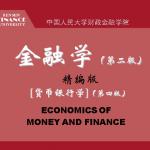广外 货币银行学期末重点 全英 米什金(2)
本站小编 免费考研网/2020-01-01
l Expected profitability of investment opportunities: in an expansion, the supply curve shifts to the right
l Expected inflation: an increase in expected inflation shifts the supply curve for bonds to the right
l Government budget: increased budget deficits shift the supply curve to the right
6. The Liquidity Preference Framework(重中之重)
7.Demand for Money in the Liquidity Preference Framework
l As the interest rate increases:
l The opportunity cost of holding money increases…
l The relative expected return of money decreases…
l …and therefore the quantity demanded of money decreases.
8.Shifts in the Demand for Money(都很重要)
l Income Effect: a higher level of income causes the demand for money at each interest rate to increase and the demand curve to shift to the right
l Price-Level Effect: a rise in the price level causes the demand for money at each interest rate to increase and the demand curve to shift to the right
l Liquidity preference framework leads to the conclusion that an increase in the money supply will lower interest rates: the liquidity effect.
l Income effect finds interest rates rising because increasing the money supply is an expansionary influence on the economy (the demand curve shifts to the right).
Chapter9:Banking
1.The Bank Balance Sheet
l Liabilities
l Checkable deposits
l Nontransaction deposits
l Borrowings
l Bank capital
l Assets
l Reserves(准备金)
l Cash items in process of collection
l Deposits at other banks
l Securities
l Loans
l Other assets
2.Basic Banking:
l Cash Deposit:Opening of a checking account leads to an increase in the bank’s reserves equal to the increase in checkable deposits
Check Deposit
3.Inter-business
l Bank settlement
l Finance lease
l Fiduciary business
l Safe deposit box
4. Off-Balance-Sheet Activities
l Loan sales (secondary loan participation)
l Generation of fee income. Examples:
Chapter12:Central Banks and the Federal Reserve System(此章省略很多)
1. Structure of the Fed(了解即可)
Board of Governors(7人)
12 FRBs(9人) Member Banks
FOMC (7+1+4人)
Federal Advisory Council (12人)
2. Federal Reserve Bank(3+3+3人)
Functions:
Clear checks
Issue new currency
Withdraw damaged currency from circulation
Administer and make discount loans to banks in their districts
Evaluate proposed mergers and applications for banks to expand their activities
Act as liaisons between the business community and the Federal Reserve System
Examine bank holding companies and state-chartered member banks
Collect data on local business conditions
Use staffs of professional economists to research topics related to the conduct of monetary policy
Chapter13&14:The Money Supply Process:
1. Players in the Money Supply Process
Central bank (Federal Reserve System)
Banks (depository institutions; financial intermediaries)
Depositors (individuals and institutions)
2.Fed’s Balance Sheet
Federal Reserve System
Assets
Liabilities
Government securities
Currency in circulation
Discount loans
Reserves
3.Monetary Base
4.Open Market Purchase
l The effect of an open market purchase on reserves depends on whether the seller of the bonds keeps the proceeds from the sale in currency or in deposits
l The effect of an open market purchase on the monetary base always increases the monetary base by the amount of the purchase
Open Market Sale
l Reduces the monetary base by the amount of the sale
l Reserves remain unchanged
The effect of open market operations on the monetary base is much more certain than the effect on reserves
5. Fed’s Ability to Control the Monetary Base
Split the monetary base into two components :
MBn= MB - BR
the non-borrowed monetary base :MBn
borrowed reserves:BR
6.The Formula for Multiple Deposit Creation(很重要!必考,记住公式)
7. Factors that Determine the Money Supply
Changes in the nonborrowed monetary base MBn
Changes in borrowed reserves from the Fed
Changes in the required reserves ratio
Changes in currency holdings
Changes in excess reserves
8. The Money Multiplier(重点)
Assume that the desired holdings of currency C and excess reserves ER grow proportionally with checkable deposits D. Then,
c = {C/D} = currency ratio
e = {ER/D} = excess reserves ratio
The monetary base MB equals currency (C) plus reserves (R):
MB = C + R = C + (r x D) + ER
M=m*MB=m*(MBn+BR)
M=1+c/r+e+c
Chapter 15:Tools of Monetary Policy
1. Tools of Monetary Policy
Open market operations
Changes in borrowed reserves
Changes in reserve requirements
Federal funds rate: the interest rate on overnight loans of reserves from one bank to another
2.Demand in the Market for Reserves
Supply in the Market for Reserves
3.Affecting the Federal Funds Rate
4.Open Market Operations(超级重点)
Advantages:
The Fed has complete control over the volume
Flexible and precise
Easily reversed
Quickly implemented
5.Discount Policy(超级重点)
Advantages:
Used to perform role of lender of last resort
disadvantages:
Cannot be controlled by the Fed; the decision maker is the bank
6.Reserve Requirements(超级重点)
Advantages:
l No longer binding for most banks
disadvantages:
l Can cause liquidity problems
l Increases uncertainty for banks
7. Monetary Policy Tools of the European Central Bank
l Open market operations
l Lending to banks
l Reserve Requirements
Chapter16:The Conduct of Monetary Policy: Strategy and Tactics
1. Goals of Monetary Policy
(1)The Price Stability Goal
l Low and stable inflation
l Inflation
l Nominal anchor to contain inflation expectations
l Time-inconsistency problem
(2)Other Goals of Monetary Policy
l High employment
l Economic growth
l Stability of financial markets
l Interest-rate stability
l Foreign exchange market stability
2. Monetary Targeting
l Advantages
l Almost immediate signals help fix inflation expectations and produce less inflation
l Almost immediate accountability
l Disadvantages
l Must be a strong and reliable relationship between the goal variable and the targeted monetary aggregate
3. Inflation Targeting
l Public announcement of medium-term numerical target for inflation
l Institutional commitment to price stability as the primary, long-run goal of monetary policy and a commitment to achieve the inflation goal
l Information-inclusive approach in which many variables are used in making decisions
l Advantages
l Does not rely on one variable to achieve target
l Easily understood
l Reduces potential of falling in time-inconsistency trap
相关话题/货币银行学
金融硕士考研货币银行学复习方法
一、货币银行学框架货币银行学这门学科按字面的意思分为货币和银行两部分。现代的经济是货币经济,也就是说生产、分配、交换、消费必须依靠货币来进行。货币是基于人们对货币发行当局的信任而存在的,货币的出现为复杂的资源分配提供了一个简单的机制,即价格机制,通过价格决定每个人应该得到什么,应该生产什么,从而达到 ...金融硕士经验 本站小编 免费考研网 2019-12-12黄达金融学PPT课件精编版 货币银行学 第四版
 .. ...专业课考研资料 本站小编 免费考研网 2019-04-10
.. ...专业课考研资料 本站小编 免费考研网 2019-04-10四川大学货币银行学笔记
《货币银行学》概念缩略【川大版】 货币职能:交易职能、价值标准、延期支付、价值贮藏。 货币种类:实物货币(作为交易媒介的货币与商品价值量相等的货币)、信用货币(其本身 价值不与商品价值相等,但是其不能代表任何商品价值的货币)。 实物货币种类:实体货币、代表实物货币或者代用货币。前者是指,作为交易媒介 ...专业课考研资料 本站小编 免费考研网 2019-04-07对外经贸大学货币银行学作业、习题及答案
一、作业与习题 第一章 货币与货币制度 【作业与练习】 1. 基本概念:价值尺度 流通手段 支付手段 贮藏手段 铸币 信用货币 纸币 银行券 本位币 无限法偿 有限法偿 准货币 2. 试述货币的定义。 3. 比较货币职能的不同表述。 4. 试论货币在当代发达的市场经济条件下的作用。 5. 试述货币制度的基本构成要素。 6. ...专业课考研资料 本站小编 免费考研网 2019-04-05对外经贸大学货币银行学笔记
对外经贸大学货币银行学笔记 第一章货币的起源、本质和职能 一、 起源 货币产生于商品交换发展 为什么商品交换发展必定会产生货币 ①作为商品,具有使用价值和价值,两者密切结合,系于商品本身直接物物交换的特点。 ②货币的产生解决了直接物物交换的困难,整个商品流通由货币组成了一个链条。 不能解决私有 ...专业课考研资料 本站小编 免费考研网 2019-03-28西南财经大学货币银行学笔记
货币银行学笔记货币银行学:①含义;②研究的核心货币;③货币银行学的局限性:没能很好地把货币银行与金融市场联系起来。 货币与货币制度问题:(1)、是否作为交换媒介的商品就是货币?为什么?(是的,货币的演进)。(2)、货币是一般等价物,其内涵是什么?(货币是商品,有价值,商品充当交易媒介) ...专业课考研资料 本站小编 免费考研网 2019-03-27货币银行学学习笔记
《货币银行学》学习笔记 一、货币 1.信用货币、电子货币、0M、1M、2M、准货币 信用货币是货币的较高发展形式,它是指作为货币的价值大于其作为商品的价值的货币。它替代金属货币,在商品经济中充当流通手段和支付手段。①货币执行流通手段职能时,只在买卖瞬间起作用,人们只关心其购买力,并不关心货币本身有无价值,所以 ...专业课考研资料 本站小编 免费考研网 2019-03-25四川大学货币银行学考研复习笔记
《货币银行学》概念缩略【川大版】 货币职能:交易职能、价值标准、延期支付、价值贮藏。 货币种类:实物货币(作为交易媒介的货币与商品价值量相等的货币)、信用货币(其本身价值不与商品价值相等,但是其不能代表任何商品价值的货币)。 实物货币种类:实体货币、代表实物货币或者代用货币。前者是指,作为交易媒介 ...专业课考研资料 本站小编 免费考研网 2019-03-17金融-备考笔记-货币银行学-胡庆康
金融联考备考笔记-货币银行学 之三:货币银行学 注意:下文提及的结构与图表来自复旦出版社出版的《货币银行学》胡庆康编写 这本书是指定参考书 货币银行学和国际金融学不同于西方经济学,总的来说难度要小的多,没有复杂的模型和数学推导,而且其考试的特点是只会出现名词解释、计算题(简单的套公式和加减乘除)、 ...专业课考研资料 本站小编 免费考研网 2019-03-172018西北师范大学货币银行学考研金融复试复习题答案
 货币与货币制度 一、填空 1、从货币本质出发,货币是固定充当(一般等价物)的特殊商品;从价值规律的角度看,货币是核算(一般等价物)的工具。 2、古今中外很多思想家和经济学家都看到了货币的起源与(交换发展)的联系。 3、银行券是随 ...专业课考研资料 本站小编 免费考研网 2018-03-29
货币与货币制度 一、填空 1、从货币本质出发,货币是固定充当(一般等价物)的特殊商品;从价值规律的角度看,货币是核算(一般等价物)的工具。 2、古今中外很多思想家和经济学家都看到了货币的起源与(交换发展)的联系。 3、银行券是随 ...专业课考研资料 本站小编 免费考研网 2018-03-29西南大学2006年考研真题-货币银行学
专业课考研经验 本站小编 FreeKaoyan 2018-01-23河北大学2005年考研真题-货币银行学
专业课考研经验 本站小编 FreeKaoyan 2018-01-23中国人民银行研究生部2000年考研真题-货币银行学综合
一、简答题(每题5分,共50分)1.特别提款权2.自然失业率3.普惠制4.互助基金(MUTUALFUND)5.税收的特征6.完全市场竞争7.要约与要约邀请8.保险价值与保险金额9.二板市场10.国内生产总值平减指数与消费物价指数 二、简述题(每题10分,共50分)1.影响需求弹性的因素有哪些?2. ...专业课考研经验 本站小编 FreeKaoyan 2018-01-22中国人民银行研究生部2001年考研真题-货币银行学综合
一、简答题(每题5分,共50分): 1、效用 2、局部均衡和一般均衡 3、购买力平价 4、替代与互补 5、财政的经济职能 6、再保险 7、国际金融市场是由哪几个子市场构成的 8、借款合同的概念及其主要条款 9、什么是货币的贮藏手段 10、什么是商业汇票 二、简述题(每题10分,共50分): 1、解释 ...专业课考研经验 本站小编 FreeKaoyan 2018-01-22中国人民银行研究生部2000年考研真题-货币银行学
一、简答(每题5分,共40分)l、货币交上有过哪几种主要的货币本位制?2、怎样衡量金融资产的流动性?3、商业银行分业经营的主要内容是什么?4、其它条件一定,假定某上市公司股票下一年的预期收益是每股0.5,市场利率为5%,其理论股价应是多少?若市场利率降至4%,理论股价又应为多少?5、国际收支表中,资 ...专业课考研经验 本站小编 FreeKaoyan 2018-01-22
